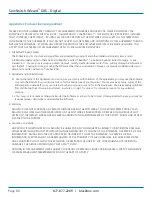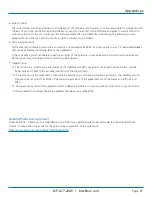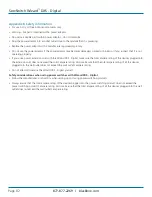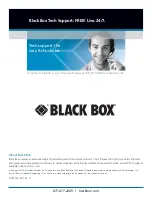
Appendices
877-877-2269 | blackbox.com
Page 75
Address allocation
Every device attached to an IPv6 network usually has more than one address type. The two most common types are called a
link-
local address
and a
global address
and these can be assigned in a number of ways.
In IPv4, device addresses are most commonly assigned either manually or by using a Dynamic Host Configuration Protocol server
(DHCP). IPv6 also offers manual addressing and DHCP (now called DHCPv6 and fully supported by the Wizard DXS - Digital unit),
but also allows devices to automatically configure their own addresses using a series of steps defined as
StateLess Address
AutoConfiguration
(or
SLAAC
). The key parts of the SLAAC procedure occur roughly as follows:
• The IPv6 compliant device creates a
tentative local identifier
which is usually derived from its fixed unique hardware identifier
(or MAC address). The local identifier is 64 bits in length (the lower half of the full 128 bit address) and this is one of the
advantages of having a fixed subnet size; it is very straightforward to automatically figure out the boundaries and contents of
the local network. This is exactly what the device does next with its tentative local identifier.
• The device uses the
Neighbor Discovery Protocol
(part of the
Internet Control Message Protocol
suite –
IMCPv6
) to check within
the local network whether its tentative local identifier is being used by any other device. If it is, then the device will create a
new one and start the process again. If the local identifier is unique within the local network, it is then combined with the
standard link-local prefix (
fe80::
) to form a valid link-local address. At this stage the address is valid only for communication
within the local network. The next stage is to replace the link-local prefix with a global prefix and then carry out a similar
procedure in order to prevent address duplication, resulting in a validated global address.
Mixing IPv4 and IPv6
Although IPv6 is based upon, and shares a number of similarities with IPv4, there are great differences in their address spaces and
other key details which mean that they are not directly compatible. This means that while computers and their operating systems
can support both types, IPv4 and IPv6 networks exist essentially as two parallel, independent entities with numerous cross over
points (known as
relay routers
). For the foreseeable future, while both versions coexist, exchanging traffic between them will
require many relay routers and various transition techniques.
One such technique involves
IPv4-mapped IPv6 addresses
. These are used in operating systems and applications that transparently
support both IP formats. In such cases IPv6 will be the native format with IPv4 fully supported whenever necessary. When an IPv4
address must be incorporated, it is placed into a special IPv6 address that has its first 80 bits set to zero and the next 16 bits set
to one. The remaining 32 bits are where the IPv4 address is embedded. When written, the address is an amalgam of the two
network types - ::ffff:192.0.2.128
Содержание ACR101A-DVI
Страница 31: ...Chapter 5 Operation 877 877 2269 blackbox com Page 31 ...
Страница 49: ...Appendices 877 877 2269 blackbox com Page 49 ...
Страница 83: ...Appendices 877 877 2269 blackbox com Page 83 ...
























